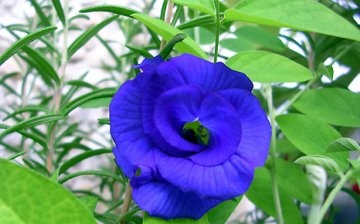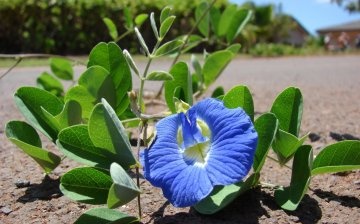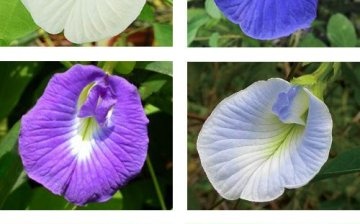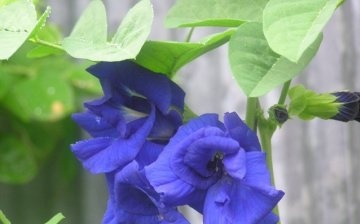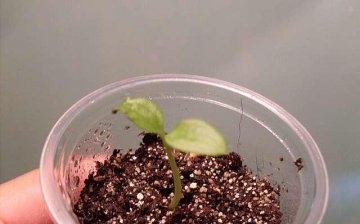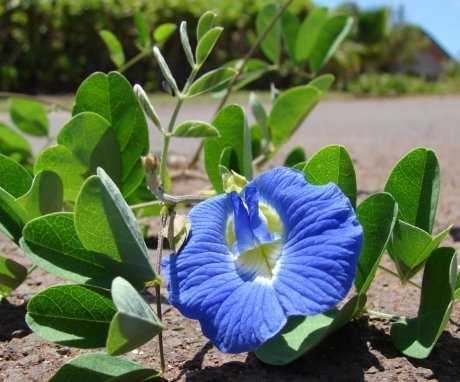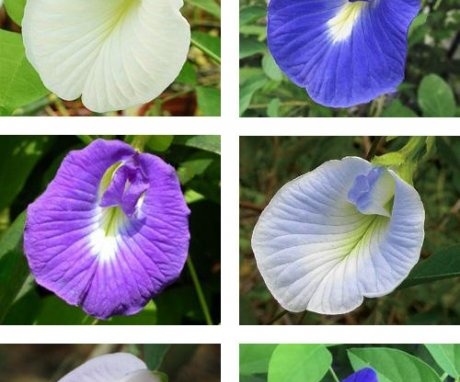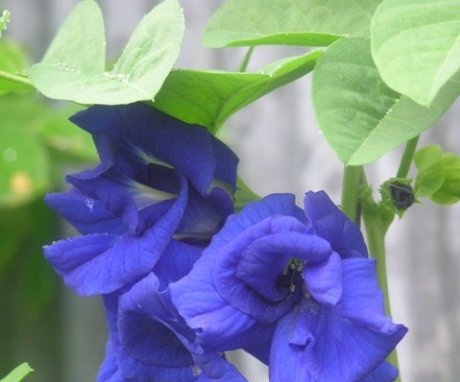Clitoria trifoliate: characteristics and types of plants, as well as reproduction and care of the flower
The trifoliate clitoris is not only an attractive flower, but also a fairly useful plant that is widely used in medicine. Due to its ease of care, this plant is very popular among gardeners. This plant is characterized by ease of care and reproduction, which allows even an inexperienced gardener to perform this action.
Content:
- Plant features
- Types of clitoris
- Features of growing a plant
- Reproduction of the clitoris trifoliate
Plant features
Characteristics of the trifoliate clitoris:
- This plant belongs to the legume family.
- It's evergreen herbaceous vine, which has rather thin shoots.
- The liana can be up to 3.5 meters long.
- The leaves of this plant are characterized by featheriness. They are characterized by a bright green color. The composition of the sheet can include from three to five leaves.
- The flowers of this plant are quite large in size. In diameter, they can reach about 5 centimeters.
- The flowers of the trifoliate clitorium are characterized by axillary. The calyx of the flower has a tubular shape.
- Also, this plant is characterized by the presence of a moth-type corolla.
- The sail is much larger than the other four petals.
- The corolla can be of various colors. Its gamut can be from lilac to blue.
The color of the corolla directly depends on the variety.
This plant is pollinated with the help of insects. These insects climb inside the scallop and pollinate. This plant has fruits that are 4 to 13 centimeters long.
Types of clitoris
The trifoliate clitoris has several varieties. The most common are: Legend clitoria, Ternatskaya clitoria, Ternatskaya clitoria.
Clitoria Legend is:
- Valuable enough medicinal plants.
- It is grown primarily indoors.
- It is also possible to plant this plant in open ground.
- This plant has bright green foliage and purple flowers with a white center.
Clitoria Terry is:
- Quite an original plant due to the attractive appearance of the flowers.
- The liana can be up to three meters long.
- The foliage of the clitorium of this variety is collected in inflorescences of 3-5 leaves.
- The leaves are characterized by a dark green color, and the flowers have a double structure and are colored dark purple.
The clitoria of ternata is:
- The most common species in our country.
- The fruits of this plant resemble beans in appearance and reach 10 centimeters in size.
- This plant is characterized by dark green foliage.
- The color of the flowers of this variety of clitoria is pale purple.
Features of growing a plant
This plant is quite thermophilic, so it must be grown at a temperature that does not exceed 10 degrees.
When disembarking the trifoliate clitoris, it is necessary to choose a well-lit place. This plant loves moisture very much, which requires make regular watering. As for the soil, for the clitoria it is necessary to choose a soil from peat, humus, river sand and sod land. In order to avoid waterlogging, the soil must be very well drained.
The clitoria is very fond of moisture:
- Therefore, she needs to ensure not only timely watering, but also foliage spraying.
- For this purpose, it is best to use settled water.
- This procedure is performed in the evening at sunset.
- In order for the clitoris to grow much faster, it is necessary to push the soil after each watering. That is, if this plant was watered tonight, then the next day it is necessary to push the soil around its rhizome.
The clitorium is a rather aggressive plant, so it is necessary to choose a place for planting it. If the trifoliate clitoris will closely coexist with weaker plants, then its vines can eventually destroy its neighbors. It is best to build a powerful support for this plant, which will allow the vines to curl. This will have a beneficial effect not only on the growth of the plant, but also on its development.
This plant needs to be fed regularly.
For this purpose, mineral fertilizers are used. Plant feeding is made regularly from early spring to late autumn. Many gardeners grow clitoria trifoliate as an annual plant. If this vine is grown as a perennial, then in the autumn period it must be provided with an image. When growing this plant outdoors, it needs to provide shelter for the winter. Otherwise, it may not come to life in the spring.
For the winter, this plant must be covered with a layer of foliage, which will most reliably protect the plant from the effects of low temperatures. But it is best to dig out the clitoris for the winter and place it in a room with a positive temperature. When storing the clitoris, it is necessary to adhere to a temperature of 10 to 12 degrees. Otherwise, this plant may not germinate on time.
The clitoris is quite resistant to a variety of diseases. But at the same time, it can be affected by pests such as ticks.
It is best to use a spray method to control these insects. For this purpose, special insecticides are used, which can be purchased at a specialized store. It is necessary to dilute the insecticide solution in accordance with the instructions indicated by the manufacturer on the package.
Reproduction of the clitoris trifoliate
Reproduction of the trifoliate clitoris is done in three ways:
- Cuttings.
- Seedlings.
- Seeds.
In order to reproduce this plant cuttings, it is necessary to take material from an adult plant. This action is performed from April to July. For rooting, cuttings are placed in peat tablets or wet perlite.
Planting seeds of clitoria trifoliate is carried out at the end of April or at the beginning of May. The plant should develop with increasing daylight hours, so the seeds are planted in open ground with good daylight. Before planting seeds, they must be soaked for 3-4 hours in a growth stimulant solution or in ordinary water.
When clitoria is propagated by seedlings, it is necessary:
- Initially, plant the seeds. To do this, first of all, you need to prepare a favorable soil from a mixture of leafy earth, river sand and peat.
- Seeds are planted in special boxes at the end of February or at the beginning of March.
- The containers with the planted seeds are placed in a warm place, the temperature of which should be about 20 degrees.
- The container with seeds can be covered with foil. This will greatly speed up the seed germination process.
- At the same time, containers require regular watering and daily ventilation.
- Seedlings of the trifoliate clitorium appear 10 days after planting the seeds.
After the seedlings of this plant get stronger, it is necessary to dive them into separate pots.
The trifoliate clitoria is planted in open ground only after the end of frost. Otherwise, this plant will not withstand low temperatures and will die. When planting creepers in the ground, it is provided with constant support, which will significantly accelerate the growth of the plant. Seedlings need to be watered regularly. Despite the fact that this plant loves moisture, you should not overdo it with watering. With excessive moisture, the root system of the clitoris can become sick. Watering is carried out with partial drying of the soil. Also, this plant needs to be fed regularly.
If comfortable conditions have been created for the trifoliate clitoris, then its flowering will begin in the middle of summer.
With proper care of the trifoliate clitoris, this plant can bloom fully long years. Caring for the plant is simple enough that even the laziest gardener will not find it difficult.
More information can be found in the video.



